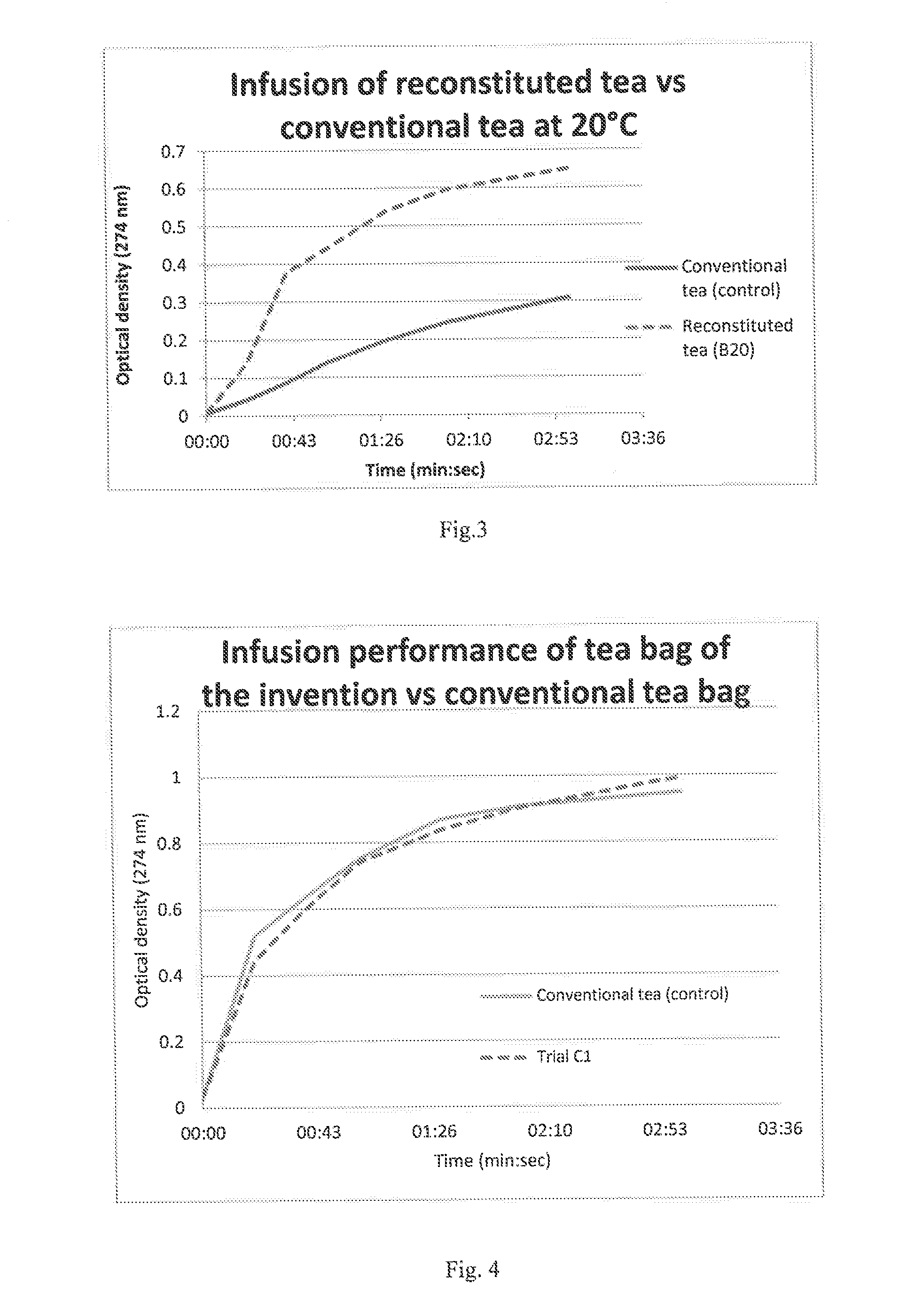Composition for Making a Tea Beverage or Herbal and Vegetable Broths
a technology of herbal and vegetable broth and tea beverage, which is applied in the field of tea beverage infusion products, can solve the problems of high variability and general strong or even bitter tas
- Summary
- Abstract
- Description
- Claims
- Application Information
AI Technical Summary
Benefits of technology
Problems solved by technology
Method used
Image
Examples
example 1
[0141]A tea product was made according to the following method: A black tea was initially heated at 85° C. for 20 minutes with a tea / water ratio of 1 to 5 by weight. This was followed by an extraction step in a hydraulic press to separate the aqueous portion from the tea fiber portion. The recovered tea fiber portion was again heated at 85° C. for 10 minutes with a tea / water ratio of 1 to 5 by weight. After an additional extraction (by pressing), the samples were then refined in a Valley beater at 1.4% consistency for 10 minutes. After refining, cellulosic fibers (a blend of abaca, hardwood and softwood pulps, with the respective ratios: 60 / 10 / 30) were added to the tea fibrous residue with a tea fiber / woodpulp ratio of 5 to 1 in weight in order to make hand sheets. The aqueous portion was concentrated in an evaporator to a solid concentration of 50% and then coated on a hand sheet on a manual size-press. The soluble level is typically between 27 and 37% in dry finished product. In e...
example 2
[0146]The product of example 1 (B20) was used to determine the infusion rate as compared to conventional tea in tea bags.
[0147]The optical densities were measured over time. The experimental set-up was identical to example 1. For the reconstituted tea product, an optical density of 0.6 was reached within 20 seconds from contacting the same with water, whereas about 2 minutes were required to obtain the same optical density using the conventional tea bag. The result is graphically shown in FIG. 2.
[0148]The example demonstrates that the reconstituted tea product provides faster infusion than conventional tea in tea bags.
[0149]Similar results were obtained when reconstituted tea was compared to tea in loose form. Also, similar results were obtained with reconstituted products made from herbs as compared to conventional herbal tea products.
example 3
[0150]The product of example 1 (B20) was used to determine its infusion properties at different temperatures as compared to conventional tea in tea bags
[0151]As in example 2, the optical densities were measured over time. The experimental set-up was identical to example 2, except for the fact that water at room temperature (20° C.) was used instead of hot water (90° C.). For the reconstituted tea product, an optical density of 0.3 was reached within about 30 seconds (0.6 within about 2 minutes) from contacting the same with water, whereas the conventional tea bag required about 6 times longer to provide the optical density of 0.3. The result is graphically shown in FIG. 3.
[0152]The example demonstrates that even in cold water the reconstituted tea product provides faster infusion than conventional tea in tea bags. At 20° C., the extraction ratio after 3 minutes of infusion is much better than standard product (+100%). Also, the extraction ratio of the reconstituted tea material at 2...
PUM
 Login to View More
Login to View More Abstract
Description
Claims
Application Information
 Login to View More
Login to View More - R&D
- Intellectual Property
- Life Sciences
- Materials
- Tech Scout
- Unparalleled Data Quality
- Higher Quality Content
- 60% Fewer Hallucinations
Browse by: Latest US Patents, China's latest patents, Technical Efficacy Thesaurus, Application Domain, Technology Topic, Popular Technical Reports.
© 2025 PatSnap. All rights reserved.Legal|Privacy policy|Modern Slavery Act Transparency Statement|Sitemap|About US| Contact US: help@patsnap.com



